Figure 1.
Stem cells exert forces and are subject to external forces, which regulate their intracellular signaling pathways. A) Intrinsic, or cell-generated forces, (Fi) are generated intracellularly and transferred to other cells through cell-cell junctions, like cadherin receptors, or via traction on extracellular matrix (ECM) adhesion ligands that are bound to integrin receptors. Cells are directly coupled by cell-cell junctions, which link the intrinsic forces of one cell to the cytoskeleton of another. Indirect mechanical coupling between cells occurs by intrinsic forces exerted on an ECM, to which two or more cells are adhered. Physical properties, e.g., elastic modulus, E, of the ECM, govern how mechanical cues are transduced. Extrinsic forces (Fe) are externally applied by shear or tension/compression on cells, and can be sensed by mechanically-gated ion channels, changes in receptor-ligand binding, deformation of the cytoskeleton, and the primary cilium. The cytoskeleton generates and transfers forces from membrane proteins to intracellular structures, like the nucleus. B) ECM and intracellular pathways are biochemically coupled by mechanotransduction pathways. Matrix mechanical resistance to intrinsic forces regulates the stability of focal adhesion complexes that contain focal adhesion kinase (FAK), which phosphorylates and activates mechano-responsive signaling elements, such as mitogen-associated protein kinase (MAPK) and Rho kinase (RhoA). RhoA regulates mechanical feedback by activating ROCK, which phosphorylates myosin light chain (MLP) to generate actomyosin forces. For example, RhoA phosphorylates ROCK, which activates non-muscle myosin II contractility by phosphorylation of myosin light chain (MLP), and upregulates mechano-transduction pathways, such as MAL, a G-actin-binding coactivator of serum response factor (SRF),88.89 Yes-associated protein (YAP), and transcriptional coactivator with PDZ-binding motif (TAZ),90 which induce nuclear transcription via activation and nuclear translocation. Nuclear signaling pathways, such as serum response factor (SRF) and myocardin-related transcription factor-A (MRFTA), regulate transcription of mechanoresponsive genes. For example, mechanics-dependent expression of miR-21 regulates fibrogenic behavior. Wnt activation also promotes activation and nuclear translocation of YAP/TAZ and beta-catenin.160 Mechanical forces are also physically directly coupled to the nucleus via lamina proteins, such as lamin A (LMNA), which can affect chromatin structure and epigenetic regulation of transcription.

